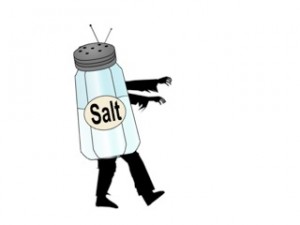 Are you afraid of salt? Is that fear based in fact?
Are you afraid of salt? Is that fear based in fact?
Sodium is key in the operation of all signals within, as well as to and from, the brain.
Salt is so essential to the body that if you drink too much water it can flush salt out of your system and cause fatal hyponatremia.
Consumption of too MUCH salt can be deadly: about 1 gram of salt per kilogram of weight will kill you. In the western world we are constantly reminded to lower our sodium intake.
Obviously salt, like anything else, can be used for good or for evil. There are variables. For example, the kind of salt you ingest really matters.
Ideally you consume unrefined sea salt. All salt came from the sea at some point. The difference is in the refining. Table salt is heavily refined where sea salt is generally sourced by evaporating water out of sea water, leaving salt.
Sea salt isn’t white. It can be grey or yellowish or pink. But never white. White is a sign of refining. Refining is a sign of reduced nutrients.
Sea salt contains as many as 84 trace minerals in addition to calcium, magnesium and potassium.
Table salt is primarily kiln-dried sodium chloride with anti-caking agents added. (18 food additives are allowed in salt!) Kiln drying involves scorching salt at high heat to remove moisture. Trace minerals, as well as calcium, magnesium and potassium are also removed creating a product that is unnatural to the body, contributing to high blood pressure, heart trouble, kidney disease and eczema, among other problems.
Besides quality, the quantity of salt ingested is a major factor. The average North American consumes two or three times the recommended daily allotment for salt, about 1500 mg. Some experts believe our health woes could be dramatically reduced (by up to 50%) if we cut our salt intake in half.
The majority of salt consumed in North America comes from processed and restaurant foods. Food manufacturers understand that salt (along with its fellow criminals, sugar and fat) is highly addictive. They have gradually added more and more salt to their products, conditioning their customers to that taste in food. They also liberally use another offensive salt, monosodium glutamate or MSG, a known neurotoxin, which excites the taste buds, providing the illusion of better taste.
If you avoid processed and restaurant foods you can better control the amount and the quality of salt in your diet and therefore control the health problems it causes or exacerbates. There are other benefits too: fewer transfats, more fibre, less sugar, etc.
Leave the shaker off the table. Or don’t cook with salt but add a little at the table, to taste, meaning taste first, then sprinkle.
Choose sea salt; it’s more expensive but you will use less of it.
Be aware of hidden salt. Soft drinks, for example, are major sources of sodium.
Many companies make salt substitutes; I prefer those made with organic herbs and spices. They are good transition products to help your taste buds return to their natural state. Be careful not to eat too little salt.
At first you may find that you miss salt but I assure you that you will quickly get used to using less. You will find that food tastes different, better and requires less seasoning in general.
Then you will find that processed and restaurant foods are often too salty to eat. I can no longer stand to eat soup in a restaurant or out of a can: too salty!
Don’t be afraid of salt. Its historical significance is no coincidence. It is vital for life.
(I first became aware of the effects of salt when I was pregnant with my first child over three decades ago. My doctor advised me of the dangers and identified some of the hidden sources of sodium. Reducing sodium gave me immediate benefit and I have been vigilant about salt ever since).
Sources:
Michael Pollen has written a number of good books including “In Defense of Food” where he discusses fat, salt, and sugar.
Mineral content of sea salt:
http://healthyeating.sfgate.com/list-minerals-sea-salt-8907.html
Hyponatremia:

